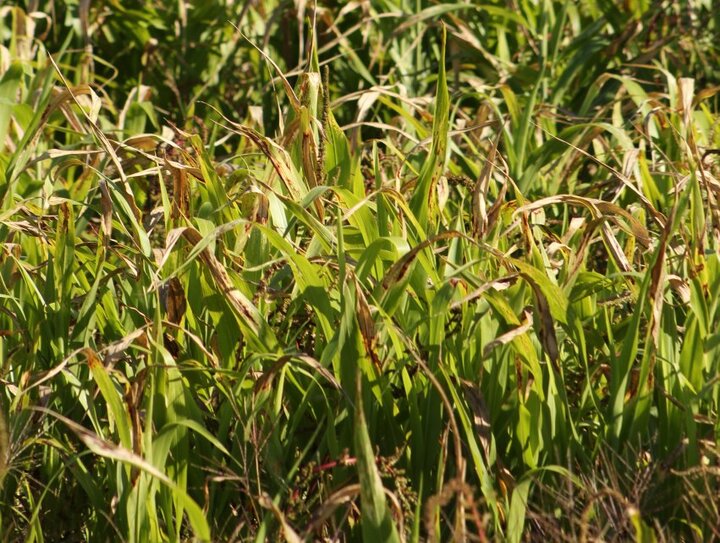When some forages are frosted, the potential for bloat, toxicity, and nitrates may increase for grazing cattle.
Bloat
When grazing alfalfa in the fall, bloat remains a potential problem, especially during the first three to five days after alfalfa has been exposed to freezing temperatures. In general, the risk of bloat will be minimal only after a significant portion (about 50-70 percent) of the alfalfa top growth has been frozen and dried. The fall freeze-down is often a slow process with many freezes over several weeks. The time it takes to reach the point where 50 to 70 percent of the alfalfa top growth has been frozen and dried will depend on the severity of the freezes and amount of standing alfalfa.
Prussic Acid
When grazing sorghums (forage or grain), sorghum-sudangrass hybrids, and sudangrass, certain conditions may cause livestock to be poisoned by prussic acid (hydrocyanic acid or cyanide). Frost is one of these conditions. Plants that are frozen may release high concentrations of prussic acid for several days. After the plant wilts, prussic acid release from the plant tissues will decline. Thus, you should remove cattle before a frost and then wait several days (5-7) after a frost to turn livestock onto these species to graze. When tops have been frosted, new shoots may regrow at the base of the plants. These can be high in prussic acid. Thus, do not graze frosted sorghum or sudan species regrowth until regrowth is 15-18 inches tall for sudan species and 24 inches tall for sorghum species. Another option is to wait several days after the entire plant and shoots are killed by subsequent frosts. Sorghum species contain the highest amount of prussic acid while sudangrass generally has the least amount. Sorghum-sudangrass hybrids are usually intermediate. Prussic acid production potential may increase with high nitrogen rates.
Pearl millet and foxtail millet have not caused prussic acid poisoning and prussic acid has not been found in these plants.
Nitrates
Frost interferes with normal plant growth and can cause nitrates to accumulate in plants that are still growing, especially grasses like oats, millet, sorghums, and sudangrass. If high nitrates are present in the plants when they undergo a total killing freeze, that nitrate level will remain in those plants and testing the forage is recommended.
For further information on the effects of frost on forages, please visit beef.unl.edu and the references below.
References
Grazing Alfalfa
Summer Annual Forage Grasses
Nitrates in Livestock Feeding
Interviews with the authors of BeefWatch newsletter articles become available throughout the month of publication and are accessible at https://go.unl.edu/podcast.
Topics covered:
Backgrounding/stocker/yearling, Forages, Grazing systems & best practices

